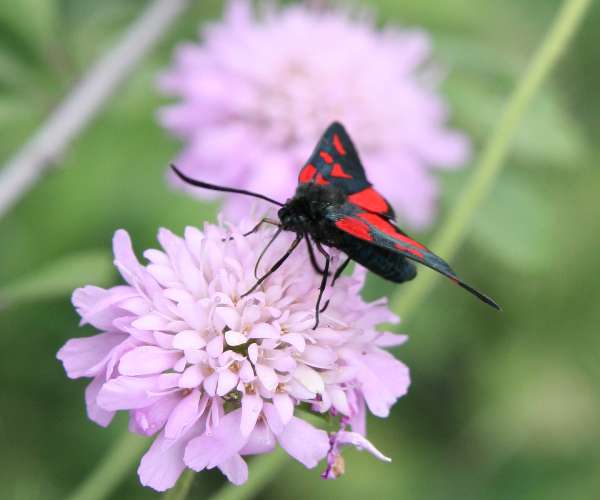Five-spot Burnet Moth - Zygaena trifolii
Phylum: Arthropoda - Class: Insecta - Order: Lepidoptera - Family: Zygaenidae

Like other members of the Burnet Moth group, this is one of the day-flying moths. In Britain it can be seen flying during July and August. Their colouring is said to warn birds against eating them because they do not taste good!
Burnets (Zygaenidae) are the only family of moths (certainly in Britain) with prominent clubbed antennae; in this respect, as well as their day-flying habit, they are like butterflies.
The wingspan range of the Five-spot Burnet Moth is 2.8 to 3.8cm.
Distribution
In Britain the Five-spot Burnet Moth occurs mainly on the dry chalk downs in southern England (Zygaena trifolii ssp. palustrella) and in damp grassland and wet heath in Wales and south-west England (Zygaena trifolii ssp. decreta), where it is mostly common near to the calcium-rich coastal strip. In recent years, the range of this moth seems to have expanded rapidly northwards, and it is now being seen increasingly in Scotland. The Five-spot Burnet Moth also occurs throughout central Europe and in northern countries of Africa.
Lifecycle

The larval foodplants of these moths are members of the pea family, Fabaceae. Caterpillars of Zygaena trifolii ssp. palustrella feed on Common Bird’s-foot Trefoil (Lotus corniculatus) commonly referred to as Bacon and Eggs - a creeping or prostrate yellow-and-orange flower commonly found in dry grassland.

Above: Caterpillar of the Five-spot Burnet Moth
The caterpillars of subspecies decreta feed on Greater Bird’s-foot Trefoil, Lotus pedunculatus, which is similar in flower form to 'Bacon and Eggs' but all yellow and generally upright and therefore much taller. Greater Bird's-foot Trefoil occurs only in damp grassland.
The Five-spot Burnet Moth overwinters (sometimes through two winters) as a larva; it pupates in early summer inside a cocoon attached to a grass stem.
Acknowledgements
This page includes pictures kindly contributed by Simon Harding.
Studying butterflies and moths...
Excited at the prospect of flyfishing? So are we, and we're pretty sure you would find the Winding River Mystery trilogy of action-packed thrillers gripping reading too. Dead Drift, Dead Cert, and Dead End are Pat O'Reilly's latest river-and-flyfishing based novels, and now they are available in ebook format. Full details on our website here...
Buy each book for just £4.96 on Amazon...
Please Help Us: If you have found this information interesting and useful, please consider helping to keep First Nature online by making a small donation towards the web hosting and internet costs.
Any donations over and above the essential running costs will help support the conservation work of Plantlife, the Rivers Trust and charitable botanic gardens - as do author royalties and publisher proceeds from books by Pat and Sue.
